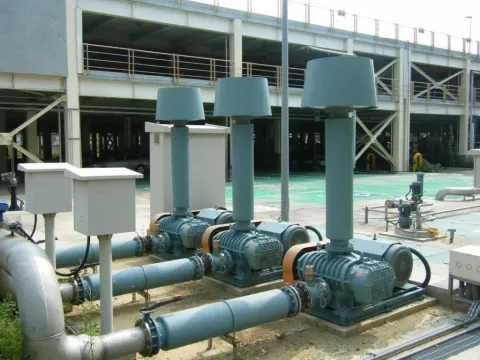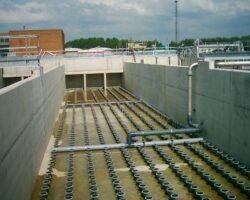Positive Displacement Blower Working Principle

Understanding the Working Principle of Positive Displacement Blowers
Introduction
Positive displacement blowers are essential components widely utilized in various industrial processes. These devices are known for their reliability and efficiency in moving air or gas through a system. Their applications span multiple sectors, including wastewater treatment, pneumatic conveying, industrial vacuum systems, and aeration processes. This article delves into the working principles of positive displacement blowers, providing an in-depth analysis that encompasses their types, functionality, applications, and advantages.
Historical Background
Positive displacement blowers have been used for over a century. The basic technology has evolved significantly since the early designs, but the core principles remain the same. The term “positive displacement” refers to the method by which these blowers transport air or gas through a system. Unlike centrifugal or axial blowers that rely on dynamic effects, positive displacement blowers move air by trapping a fixed volume and forcing (displacing) it from the inlet to the outlet.
Types of Positive Displacement Blowers
There are several main types of positive displacement blowers, each tailored to specific applications and operational requirements. These include:
-
- Rotary Lobe Blowers:
Rotary lobe blowers are perhaps the most common type of positive displacement blower. They consist of two or three lobes (rotors) that rotate in opposite directions within a housing. As the rotors turn, they create pockets of air that are trapped and then displaced from the inlet to the outlet.
- Rotary Lobe Blowers:
-
- Rotary Screw Blowers:
Rotary screw blowers operate similarly to rotary screw compressors. They use two intermeshing screws to compress and move air or gas. These blowers are known for their efficiency and smooth operation, making them suitable for continuous-duty applications.
- Rotary Screw Blowers:
-
- Rotary Vane Blowers:
Rotary vane blowers use vanes mounted on a rotor that turns inside a cavity. As the rotor spins, the vanes slide in and out, trapping and moving air from the inlet to the outlet. These blowers are generally quieter and provide a steadier flow compared to other types.
- Rotary Vane Blowers:
-
- Liquid Ring Blowers:
Liquid ring blowers employ a liquid (usually water) to create a seal within the blower housing. An eccentrically mounted impeller throws liquid against the casing, forming liquid rings that trap and move air. These blowers are commonly used for gas compression in chemical and process industries.
- Liquid Ring Blowers:
Each type of positive displacement blower has unique operational characteristics, advantages, and limitations, which make them suitable for specific industrial requirements.
Fundamental Working Principle
Despite the different designs and types, all positive displacement blowers follow a fundamental working principle: They trap a fixed volume of air or gas and then force it from the inlet to the outlet, creating a continuous flow. Here is a more detailed look into the core principles:
-
- Capture and Trapping:
At the core of a positive displacement blower’s operation is the capturing and trapping of air or gas. This is achieved through the design of the rotors, screws, or vanes, which create pockets of a fixed volume. As the rotors or vanes turn, these pockets are sealed from the inlet, preventing backflow.
- Capture and Trapping:
-
- Displacement and Transport:
Once trapped, the air or gas is then moved along the housing as the rotors or vanes continue to turn. This displacement method ensures a continuous transfer from the inlet side to the outlet side of the blower.
- Displacement and Transport:
-
- Compression (if applicable):
In some designs, particularly in rotary screw blowers, there is also a compression stage. As the screws mesh together, the trapped air or gas is compressed before reaching the outlet, increasing its pressure.
- Compression (if applicable):
-
- Discharge:
The final stage is the discharge phase, where the trapped and possibly compressed air or gas is released through the blower’s outlet. This continuous cycle of trapping, displacing, and discharging forms the basis of a positive displacement blowers’ operation.
- Discharge:
Rotary Lobe Blowers: Case Study
To illustrate the working principles more concretely, let us consider the rotary lobe blower in detail:
-
- Design and Construction:
Rotary lobe blowers comprise two rotors, each with two or three lobes, turning in opposite directions within a robust casing. The rotors are synchronized using timing gears, ensuring that they rotate without coming into contact with each other or the casing. The close tolerances between the rotors and the casing create the necessary seals for trapping air.
- Design and Construction:
-
- Operational Cycle:
The operational cycle of a rotary lobe blower includes the following steps:-
- Inlet: As the rotors turn, a low-pressure area forms at the inlet, drawing air or gas into the pockets formed by the lobes.
-
- Trapping: As the rotors continue to rotate, the lobes close against the housing, trapping the air or gas.
-
- Displacement: The trapped air or gas is displaced along the housing by the rotation of the lobes.
-
- Outlet: Finally, the displaced air or gas is expelled through the outlet at approximately the same volume it was drawn in, creating a steady flow.
-
- Operational Cycle:
-
- Key Characteristics:
Rotary lobe blowers are characterized by their ability to handle large volumes with relatively low pressure increases. They are reliable, require minimal maintenance, and can run continuously under various operating conditions.
- Key Characteristics:
Applications and Use Cases
Positive displacement blowers are integral to numerous industrial applications, including:
-
- Wastewater Treatment:
In wastewater treatment plants, positive displacement blowers are used for aeration processes, providing essential oxygen to microorganisms that break down organic matter.
- Wastewater Treatment:
-
- Pneumatic Conveying:
Industries that require the transport of granular or powdered materials often rely on positive displacement blowers for pneumatic conveying systems. The steady, non-pulsating flow of air helps in moving materials efficiently over considerable distances.
- Pneumatic Conveying:
-
- Industrial Vacuum Systems:
These blowers are vital in maintaining vacuums for industrial processes, such as packaging, material handling, and drying.
- Industrial Vacuum Systems:
-
- Aeration:
Positive displacement blowers are used for providing aeration in fish farming, fermentation processes, and even in air-cushion vehicles.
- Aeration:
-
- Combustion Air Supply:
In applications requiring a steady supply of combustion air, such as in boilers and furnaces, positive displacement blowers ensure reliable operation.
- Combustion Air Supply:
Advantages of Positive Displacement Blowers
There are several advantages to using positive displacement blowers, which include:
-
- Reliability and Durability:
These blowers are designed for continuous operation and are built to last, with robust construction minimizing wear and tear.
- Reliability and Durability:
-
- Constant Flow Rate:
Positive displacement blowers provide a consistent flow rate regardless of the pressure changes, making them ideal for applications requiring a steady airflow.
- Constant Flow Rate:
-
- Versatility:
Their ability to handle a wide range of gases and to operate under diverse conditions makes them adaptable to various industrial uses.
- Versatility:
-
- Low Maintenance:
With fewer moving parts and minimal contact between components, positive displacement blowers often require less maintenance than other types of blowers.
- Low Maintenance:
-
- Efficient Operation:
These blowers are efficient in energy utilization, providing a cost-effective solution for many industrial applications.
- Efficient Operation:
Potential Limitations
Despite their advantages, positive displacement blowers come with certain limitations:
-
- Limited Pressure Range:
Compared to centrifugal blowers, positive displacement blowers generally operate at lower pressures. This can limit their suitability for high-pressure applications.
- Limited Pressure Range:
-
- Noise Levels:
Rotary lobe blowers, in particular, can be noisier than other types, requiring additional soundproofing in some environments.
- Noise Levels:
-
- Start-up and Shutdown:
The power requirement for starting a positive displacement blower can be high, necessitating precautions during start-up and shutdown to prevent damage.
- Start-up and Shutdown:
-
- Pulsating Airflow:
Although minimized in certain designs, some positive displacement blowers may produce a pulsating airflow, which could be a limitation for applications needing ultra-smooth air delivery.
- Pulsating Airflow:
Innovations and Future Trends
The field of positive displacement blowers is not static; ongoing research and development are bringing innovations that address existing limitations and expand their functionalities:
-
- Advanced Materials:
The development of advanced materials, such as wear-resistant coatings and high-strength alloys, is improving the longevity and performance of blowers.
- Advanced Materials:
-
- Efficiency Improvements:
Enhanced rotor designs, better sealing technologies, and optimized gear configurations are contributing to improved energy efficiency and reduced operational costs.
- Efficiency Improvements:
-
- Noise Reduction:
Innovations in acoustic engineering and noise dampening technologies are making positive displacement blowers quieter, broadening their applicability.
- Noise Reduction:
-
- Smart Controls:
Integration with smart control systems and IoT devices is enabling more precise monitoring, predictive maintenance, and improved operational efficiency.
- Smart Controls:
-
- Environmental Considerations:
There is a growing focus on developing blowers that are both energy-efficient and environmentally friendly, reducing the carbon footprint of industrial processes.
- Environmental Considerations:
Conclusion
Positive displacement blowers are pivotal in numerous industrial applications, providing reliable and efficient solutions for moving air and gas. Through a detailed understanding of their working principles, types, applications, and evolving technologies, we can appreciate their vital role in modern industry. As innovation continues, these blowers will become even more versatile, efficient, and integral to industrial operations, maintaining their position as key components in achieving optimal system performance.

